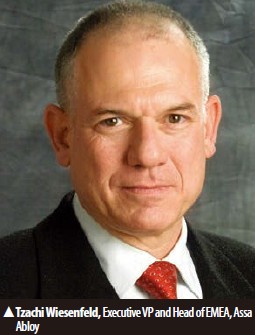Budgets may be tightened in Europe but the access control market is sustaining itself with positive growth. Activity is seen across several sectors, especially
in the UK education sector. The complexity of modern lifestyle is also driving the integration of access control with other systems.
The global access control market is set to top US$2.3 billion globally by the end of 2013, up from $2.1 billion in 2011, according to a recent report by IMS Research (an IHS company). In terms of regional markets, however, the European market is slow as a whole, but that is not reflective of the entire region. For instance, in Assa Abloy's Q1 report, the company found positive growth in the Americas and Asia, but the European economy continued to weaken, which produced a negative outcome for its EMEA market and for the entrance systems product categories. However, while some southern parts of Europe experienced organic decline in the first quarter, other parts such as Russia, East Europe, Turkey, the Middle East, and Africa experienced satisfactory growth, driven by the introduction of new products, emerging markets within the EMEA region, specification of projects, and acquisitions.
 Nevertheless, the access control market is growing amidst the tough environment. “Europe is challenging, especially the southern part of Europe, such as Italy and Spain. However, I think the access control part of the business is growing much faster than the average. In other words, even though the overall market is not growing, access control is still growing, and we are seeing a huge demand for all the new locks and technology, in spite of the sluggish market conditions,” said Tzachi Wiesenfeld, Executive VP and Head of EMEA at Assa Abloy.
Nevertheless, the access control market is growing amidst the tough environment. “Europe is challenging, especially the southern part of Europe, such as Italy and Spain. However, I think the access control part of the business is growing much faster than the average. In other words, even though the overall market is not growing, access control is still growing, and we are seeing a huge demand for all the new locks and technology, in spite of the sluggish market conditions,” said Tzachi Wiesenfeld, Executive VP and Head of EMEA at Assa Abloy.
Market Drivers
Several factors are driving the access control market. According to market intelligence provider Key Note, governments and businesses now hold an increasing amount of information about the public, consumers, and personnel. Together with the continuous threat of crime and terrorism, the need for more reliable and intelligent security systems to allow only authorized personnel into a particular site at a specified time becomes paramount.
The complexity of daily operations in an urbanized society has also driven the trend towards the integration of access control systems with other security systems.
“Over recent months we have seen a clear move from our clients and prospects towards a need for a more integrated approach but also with a view to taking advantage of new technology when it arrives over the coming years. This means that end users are starting to realize that they need to consider a solution that easily integrates with other devices. Being able to adapt access control and video to work together is still the main criteria,” noted Daryn Flynn, UK Sales Director at Nedap.
The U.K.
A European region where the access control sector is defying the general economic slowdown is the U.K. According to Key Note, the 2010 UK access control market was worth an estimated $476.3 million at the 2011 end-user prices. It further estimated that the UK access control market will grow by 12.7 percent between 2011 and 2015, driven by the recovery within the construction industry. This growth is expected to be subdued at first, due to construction output being hampered by public sector spending cuts. Growth is expected to be more significant as public sector spending recovers.
In the U.K., construction output and orders increased since 2010, generating demand for access control systems. In addition, the upgrading and refurbishment of old systems is also driving the market. “Upgrading is key driver of the market. We have a lot of projects where we upgrade old products with new products. This is not new to us though, because we estimate that two-thirds of our global business is from recurring revenue from the after-market, and only one-third is coming from new projects. Of course there are still new projects, but there are less of them compared to the past. However, the influence on us is only one-third, but on the other hand, the after-market is still going strong," noted Wiesenfeld.
Education
Even though the U.K. economy has remained relatively flat, the government increased spending in education, noted John Davies, MD of Time and Data Systems International (TDSi). The U.K. has an abundant number of old universities, many of them being the first few universities in the English-speaking world. Access control in these universities is updated as new technology is introduced into the market, such as electronic locks or integration.
According to Wiesenfeld, the education vertical has always been exciting in the U.K. “It's not new. There are hundreds and hundreds of universities and schools in the U.K., making it a huge vertical. Also, in the U.K. it is very common for students to live away from home. In dormitories, for example, the solutions required are very similar to hotels, and this makes electronic locks a natural application for them because it is easier to control, more flexible and a huge advantage over and above mechanical keys. So whilst it is not a new vertical sector, it is one that is still growing.”
“For example, universities and higher education institutes would likely install traditional electronic access controlled locks around the perimeter and main entrances of buildings, but use wireless electronic locks indoors. This enables the students to use the same smart card embedded with their credentials to access all the areas they need. Hence, for an education institute project, there might be 500 sets of locks secured via “traditional” access control, and 2,500 sets of wireless electronic locks which would be installed in halls of residence for example,” commented Davies on the education vertical.
NFC Uptake
 The uptake of NFC technology for access control in universities is growing. “Unlike hotels, where there is high turnover of guests staying for a relatively short period of time, universities are more of closed environment, in that you know how many students there are and who they are. Therefore, despite the large population you can allocate access rights to each student for a term/ semester and there will be relatively few changes thereafter," said Peter Romanov, EMEIA Sales Leader of Standard EAC Solutions at Ingersoll Rand Security Technologies.
The uptake of NFC technology for access control in universities is growing. “Unlike hotels, where there is high turnover of guests staying for a relatively short period of time, universities are more of closed environment, in that you know how many students there are and who they are. Therefore, despite the large population you can allocate access rights to each student for a term/ semester and there will be relatively few changes thereafter," said Peter Romanov, EMEIA Sales Leader of Standard EAC Solutions at Ingersoll Rand Security Technologies.
In the future, as the technology becomes more mature, TDSi plans to incorporate it into their product offering. “In the next two or three years, we plan to incorporate NFC technology into our family of readers. In addition, facial recognition is becoming more prevalent as it identifies who you are, and then you could use your mobile phone and credential to access premises and facilities,” said Davies.
Currently, the NFC infrastructure is still developing. “In order to facilitate wide market adoption, universal NFC-enabled handsets to support the existing primary operating systems will be required. Network operators will intrinsically become part of the access control equation and, ultimately, the provisioning process. Solutions will also need to support open standards to foster the availability of interoperable products and future-proof the access control infrastructure, ensuring that in investments in today's technologies can be leveraged in the future. However, given the complexity and diversity of the mobile landscape itself, all development work will be a big undertaking,” said Antony Gibson, Channel Sales Manager for the U.K. and Nordics at HID Global.
Government
The wider economic environment has tightened government budgets, and the increase in energy costs have also prompted governments to look into energy saving methods. In Europe and the U.K. in particular, government buildings are starting to set targets on the reduction of carbon dioxide emissions. This calls for the integration of access control and building management. For example, the lights may only be triggered to turn on when the access control system sends a signal. Seeing a trend in this, TDSi, for example, began integrating access control with building management, video surveillance, and intruder alarms five years ago. While the governments have not specifically enforced emission reduction rules, there is still growing demand due to the rising costs of energy in Europe.
SMB 
SMBs require access control too, but often lack the funds to take advantage of technology that is available to their larger counterparts. Salto Systems developed a solution to bring electronic access control systems to SMBs. “A cloud-based access control solution gives SMB owners the opportunity to install a wireless solution at the fraction of the cost of a hard wired access system. They only need to pay a subscription fee and with the system, they can easily manage their access control system in real-time and remotely, thus eliminating the problems and limitations of mechanical solutions,” said Marc Handels, Chief Marketing and Sales Officer at Salto Systems.
The access contorl market outlook is relatively positive. It is forecasted to grow slowly in the immediate future, but significantly in the long term. Improvements in technology, integration, and interoperability will drive competiveness in the market.